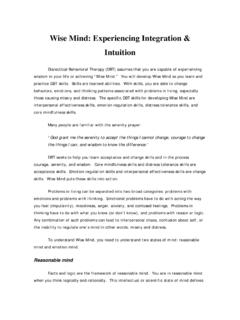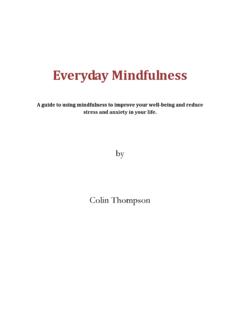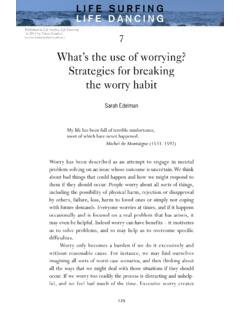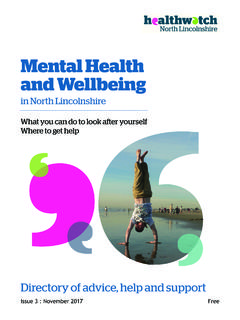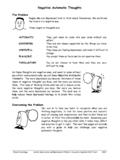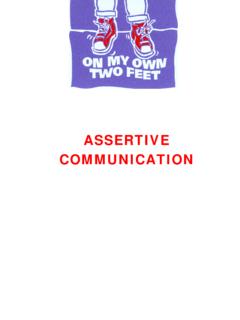Transcription of Cognitive Behaviour Therapy - DBT Self Help
1 An Introductory Self-Help Course in Cognitive Behaviour Therapy Carol Vivyan 2009 Vivyan 2009 1 This mini 7-step self-help course includes an introduction to techniques which could be useful for all, but professional help should be sought for complex or long-standing problems. The course is also available online at Contents Step Title Page Introduction to Cognitive Behaviour Therapy 2 1 Identifying Thoughts, Feelings & behaviours 5 5 Aspects of Life Experience 8 2 Understanding the links between Thoughts, Feelings & behaviours Depression, Anxiety, Anger 9 Emotions and their associated thoughts.
2 Body reactions and behaviours 15 3 Making Changes behaviours 16 Activity Diary 19 ACE Log 20 Treatment Plan 22 Communication Styles 23 4 Making Changes Thoughts 24 About Automatic Thoughts 26 Unhelpful Thinking Habits 27 Finding Alternative Thoughts 28 Different Perspectives 29 5 Challenging our Thoughts 33 The Court Case 34 Thought Record Sheet 35 Positive Affirmations 36 The Worry Tree 37 6 Defusing from our Thoughts 38 Mindfulness 40 ACT Worksheet 45 STOPP 46 Defusion Techniques 47 7 Imagery for Self-Help 48 What now? 52 Further copies of this guide, and of additional worksheets and leaflets in italics above, can be downloaded freely (in Adobe document format)
3 From Vivyan 2009 2 Cognitive Behaviour Therapy - how it can help Cognitive Behaviour Therapy is a form of psychotherapy that talks about How you think about yourself, the world and other people How what you do affects your thoughts and feelings CBT can help you to change how you think (" Cognitive ") and what you do (" Behaviour )". These changes can help you to feel better. Unlike some of the other talking treatments, it focuses on the "here and now" problems and difficulties.
4 Whilst it is often useful to discuss the past and understand how our pasts have influenced our lives and how problems have arisen, CBT mostly focuses on looking for ways to improve your mental wellbeing now. CBT says that it's not the event which causes our emotions, but how we interpret that event - what we think or what meaning we give that event or situation. For instance, if someone you know passes you in the street without acknowledging you, you can interpret it several ways. You might think they don't want to know you because no-one likes you (which may lead you to feel depressed), your thought may be that you hope they don't stop to talk to you, because you won't know what to say and they'll think you're boring and stupid (anxiety), you may think they re being deliberately snotty (leading to anger).
5 A healthier response might be that they just didn't see you. Vivyan 2009 3 Another example may be someone who's depressed might wake up in the morning and think: "This is going to be another awful day", "I'm going to mess up again", or "What's the point of anything?", which will make them feel even more depressed (feelings), and may prompt them to pull the covers over their head and stay in bed ( behaviours ). It's very likely that this will increase their negative thoughts, which in turn will increase the feelings of depression, and make them even less likely to get out of bed.
6 A vicious cycle is the result - continuing to think and act the same way will help maintain our depression (diagram below). A vicious cycle of Anxiety might look something like this: Vivyan 2009 4 CBT can help you to break these vicious cycles of negative thinking, feelings and Behaviour . When you see the parts of the vicious cycle clearly, you can change them - and therefore change the way you feel. It can also be useful to look at the way our thoughts and feelings affect our bodies, and the physical sensations we can experience Different emotions are often associated with particular types of thoughts: CBT aims to get you to a point where you can "do it yourself", and work out your own ways of tackling problems.
7 CBT has often been described as guided self-help, and this self-help course will help you learn how CBT can help you. The following self-help steps will enable you, with or without the help of a therapist or mental health professional, to gain some useful insights and begin to address and work through your problems. There are many more resources available on the website H Vivyan 2009 5 Step 1 Identifying Thoughts, Feelings & behaviours Now we can start to look at what's helping to keep your problems going.
8 Let's use a recent example, when you've been distressed - perhaps something has happened in the past week or so when you've felt particularly anxious, angry, or depressed. What was the situation? What happened? When did it happen? What else was going on? Was it a situation that you often find yourself in? Who were you with? What thoughts or images went through your mind just before or during that time? What disturbed you? If you had that thought, what did that mean to you, or what did that say about you or the situation? If your thought was a question, try to answer it.
9 Vivyan 2009 6 What distressing emotion/s did you feel? What else? Anger, anxiety, terror, rage, depression, frustration, guilt, shame, What did you notice in your body? In anxiety and anger (and excitement) the body's adrenaline can result in us feeling physical sensations which can include: heart pounding or racing, palpitations, rapid breathing, difficulty breathing, light-headed, dizzy, shaky, sweaty, hot, red, pins & needles, tense or sore muscles, urge to go to the toilet, butterflies in the tummy, warm uncomfortable feeling in the abdomen or chest, difficulty concentrating, lump in throat.
10 This is the fight & flight response - the body's survival mechanism which helps us escape or to stand up to the threat at times of real danger. The body is unable to differentiate between a real or imagined danger, so the alarm signal is pressed and activated regardless. In depression, we can feel tired, lethargic, exhausted, experience appetite and sleep changes, aches and pains, headaches, digestive changes ( constipation), agitation and feel unable to settle, experience lack of interest in sex, and have slow movement or speech. Vivyan 2009 7 What did you do?
